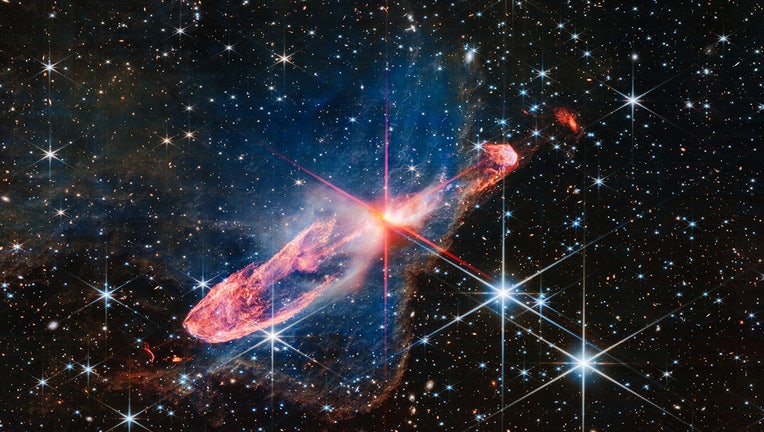Actively forming stars captured in stellar photo by Webb telescope

NASA’s James Webb Space Telescope has captured a tightly bound pair of actively forming stars, known as Herbig-Haro 46/47, in high-resolution near-infrared light. (NASA, ESA, CSA. Image Processing: Joseph DePasquale (STScI))
Now that’s an action shot.
The James Webb Space Telescope has once again captured a stellar photo of a pair of actively forming young stars, NASA shared on Wednesday.
The stars are named Herbig-Haro 46/47 and they are floating deep within a disk of gas and dust that is actively feeding the pair’s growth, NASA said in a news release.
In the photo, among a sea of sparkling stars, a giant red gaseous disk is seen and toward the right side of the disk, a diffraction spike shines brightly.
"Along the right side, these ejections make clearer wavy patterns. They are disconnected at points, and end in a remarkable uneven light purple circle in the thickest orange area. Lighter blue, curly lines also emerge on the left, near the central stars, but are sometimes overshadowed by the bright red diffraction spike," NASA said.
Diffraction spikes are basically the result of how the light of a star hits the Webb telescope’s enormous hexagonal mirror, making stars appear to "shine bright like a diamond," to borrow Rihanna’s lyrics.
Thanks to the Webb telescope’s infrared image, scientists are also able to observe the surrounding blue nebula, also known as a Bok globule, according to the space agency.
Without the infrared imaging, the nebula would be invisible.
"This nebula is significant – its presence influences the shapes of the jets shot out by the central stars. As ejected material rams into the nebula on the lower left, there is more opportunity for the jets to interact with molecules within the nebula, causing them both to light up," NASA said.
Herbig-Haro 46/47 have a few more million years before they become fully-formed stars. The stars are also relatively close to Earth, only 1,470 light years away in the Vela constellation.
This story was reported from Los Angeles.

